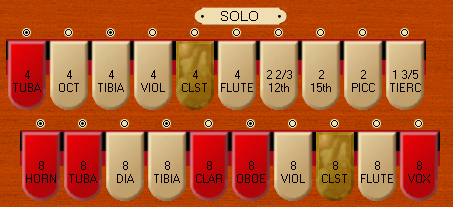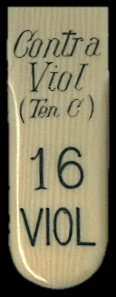
The MiditzerConsole
Stops, part 2...
The stops for each keyboard are selected to support the usual purpose of the
keyboard. You can do whatever you want in playing but knowing the
intended purpose will give you a better idea of where to start.
The second keyboard from the bottom is intended to provide the melodic
and solo parts. It has the largest number of stops and almost
every sound available can be played from the this manual.
On a two manual Wurlitzer this will be the upper manual and it is called the Solo
manual. On a three manual Wurlitzer this will be the middle keyboard and it is called the
Great. Other makes of two manual organs may call the upper manual
the Great as that is how it is named on a classical organ. On a
three manual organ the uppermost manual is generally called the Solo
but this Solo manual is intended for solo and accent parts and the
number of stops is generally much less including just stops suitable
for solo type parts.
At this point it may be helpful to briefly discuss unification. This is a
characteristic of theatre organs and it is viewed with great disdain by
classical organists. In a classical organ, the pipes are also
arranged in divisions that correspond to the manuals; every stop for a
manual and its associated pipes are dedicated to that manual or
division. Classical organs are literally a collection of one
manual organs grouped together. If a Flute stop appeared on the
Great and on the Accompaniment there would be two ranks of Flutes and if you played
middle C on both manuals two pipes would speak.
Theatre organs were designed for economy of construction to fit in theatres where
space was at a premium. Hope-Jones conceived of using an increase
in the complexity of the connection of the keys and stops to the pipes
made possible by the use of the electro pneumatic action to reuse the
same pipes for all the manuals. In a theatre organ, if a stop appeared on
the Solo and on the Accompaniment there would be only one rank of pipes and if you played
middle C on both manuals only one pipe would speak. If you have
two keyboards connected to the Miditzer you can try this for yourself
because the Miditzer accurately reproduces the unified construction of
a theatre organ. Unification is neither a good thing nor a bad
thing. It is just the way theatre organs are built. Theatre
organ music takes advantage of unification because it allows dense
chords to be played without unduly building up the number of pipes
speaking in the middle of the ensemble. You do need to consider
whether or not an organ is unified in planning your use of stops.

Looking at the upper right of the Miditzer screen you will see the stops for the Solo
manual. There are 10 stop tabs in the lower row, all having the
number 8 on them. A Style 216 Wurlitzer has 10 ranks of pipes and
these 10 stop tabs will allow you to play pipes in each of those 10
ranks from the Solo (upper) manual. The tabs in the Miditzer have
abbreviated names because of space
considerations. A real stop tab has more information like this:

The number 8 means 8 foot pitch. This is the circuitous way organ builders
indicate that the stop will play at the nominal or unison pitch of the
keys. In other words the A above middle C will be 440 Hertz,
concert A. An open pipe for the lowest C on the keyboard at
unison pitch is approximately 8 feet long. Some stops, like the Tibia,
are stopped pipes that have their top end closed. Stopped pipes
are half the length of an open pipe of the same pitch. So a
stopped pipe for the lowest C would be 4 feet long, but the stop tab will say 8.
The tabs for a given pitch are arranged roughly from loudest to softest, left to right. The red tabs indicate the reed stops which are the pipes that have a vibrating reed in the foot of the pipe. The white tabs indicate flue stops which are pipes with no moving parts. The yellow tabs indicate a celeste stop which is a rank of pipes that is deliberately slightly out of tune. Most Wurlitzers include a Viol Celeste. If you add the Viol Celeste to the Viol it will create a "beat" that gives a shimmering quality to the resulting sound. The best way to understand what the stops do is to play the Miditzer and listen to the sound produced by the stops. From here on, I will just assume you will experiment with the stops to hear what the stops do as you work through the descriptions.
In the upper row of the stops pictured above you see stops with the number 4. As
you might guess this means that an open pipe for the lowest C would be
4 feet long. A pipe that is half as long plays an octave
higher. Stops marked 4 play an octave higher than the nominal
pitch of the key. You will note that almost all the tabs have the
same names as 8 foot stops on the row below. In a theatre organ,
the 4 foot stops are playing exactly the same pipes as the
corresponding 8 foot stop, just an octave higher. The "4 OCT" for
Octave is the Diapason, just to confuse the innocent.